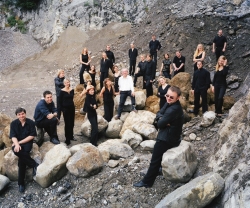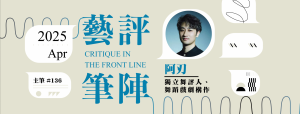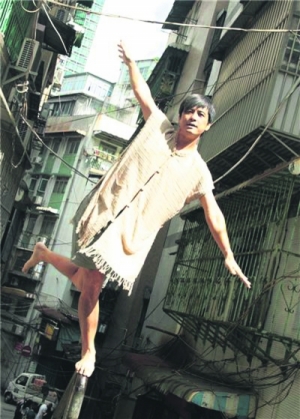 |
The world-class Latvian violinist Gidon Kremer and Kremerata Baltica are touring Asia, including South Korea, Macao, China, Taiwan, and Japan. The performance this night was the fifth concert in this tour. It was held in Macao Cultural Centre Grand Auditorium as an event in the 29th Macao International Music Festival.
The first piece was Fratres (1977) by Arvo Pärt. It featured an eight-chord ostinato throughout. It was a good starting piece for the players to warm up their instruments. The drone in the lower strings was held stably. Kremer’s execution on harmonics was highly precise, and the resultant sonority was celestial.
Succeeding the post-minimal composition, the ensemble brought to the audience Concertino for violin and string orchestra (1948) by Mieczyslaw Weinberg. The tempo and tightness between the solo and orchestra required more attentions.
Excerpts from The Art of Instrumentation: Homage to Glenn Gould – Dedicated to J. S. Bach was then featured. It was a CD album that released in 2012. The release date was carefully timed to coincide with Glenn Gould’s 80th birthday and 20th anniversary of his death. This project invited several composers to create string-orchestra version of compositions (new works and arrangements) that were inspired by Gould’s repertoire.
The opening piece from the album was Valentin Silvestrov’s Dedication to J. S. B. for Violin and “Echo” Sounds. The “echoes” were subtly achieved in a twofold manner. The acoustic echoes of violin were captured and achieved by the vibraphone. With the careful choice of mallets and appropriate strength of execution, the vibraphone player Andrei Pushkarev skilfully highlighted and decorated the lingering sounds from violin. The strikes were so soft that one would hear the vibraphone’s tones as reverberations from the violin. The composition itself was a reminiscence of Bach’s Chaconne from Partita No. 2 for violin. Hence historically echoing the structure, form, and harmony of the Chaconne, as clearly revealed by its minor-major-minor tonality and repeated chordal structure. The notated phrasing carefully captured the Baroque articulation by added slight pause to each phrase.
The second excerpt Quarter = 87 by Andrius Žlabys featured tutti playing. This piece was of neo-Baroque style, alternating between Baroque-like melodies and some tone clusters in the middle.
Steven Kovacs Tickmayer’s arrangements started with the “Quodlibet” from Goldberg Variations. The contrapuntal melodies were clearly displayed among lines. Tickmaver’s arrangement consisted of Bach’s Goldberg Variations Nos. 30, 4, 18 and 26, and Arnold Schoenberg’s Three Intermezzi from op. 19 and op. 47. Bach and Schoenberg’s miniatures were heard in an alternating manner. The players’ abilities in swapping quickly among styles were well observed. This was especially noted in the third intermezzi, where highly disjunct dissonant leaps were heard. These figurations were alien to what they had been playing for the whole concert. Yet, they had not failed in executing these accurately.
For Victor Kissine’s “Aria” from the Goldberg Variations, it featured an interesting juxtaposition of Gould’s recording on “Aria”, and materials performed by the string orchestra. This nostalgic echo with the past was a beautiful idea, yet the presentation of recording gave a drawback. The hissing from the amplifiers was obviously noticeable, and one would think that the amplifiers were accidentally turned on until they realised it was set up for the Gould’s interpretation. A slow violin passage with bowing crotales opened and closed the piece. Yet these introduction and codetta was a bit clumsy and unnecessary. Despite that, the arranged materials displayed some skilful pointillistic treatments, particularly prevailing on the viola and second violin parts. This beautiful aria concluded the first half of the concert.
The second half of the concert featured a joint video project namely “Russia: Masks and Faces,” which was obviously the title of the concert this night. For the visual part, one would consider these as animations rather than video. The images, which drew inspirations from Mussorgsky’s Pictures at an Exhibition, were paintings by Maxim Kantor. Merely was there zooming in and out of the images, there was no significant movements to make it a “video.” The paintings were of expressionist’s traits, featuring cold colours like brown and blue, using strong and bold brushstrokes. The paintings focused on the repressed sufferings of human beings.
Return back to the musical aspect, three pieces were performed: Igor Loboda’s Requiem for Ukraine for violin solo, Mussorgsky’s Pictures at an Exhibition (arr. for string orchestra by Jacques Cohen), and Valentin Silvestrov’s Serenade for violin solo.
The opening piece, “Requiem for Ukraine,”in this animation was composed by Georgian composer Igor Loboda. Kremer presented this assertive miniature with a hint of anger and melancholy. It was a firm response to the Ukrainian people’s sufferings.
Kremerata Baltica took up their turn after Kremer’s solo. The string orchestra performed without a conductor, nor was there any cue for most of the entries. A conductor would be proved unnecessary for this charming orchestra, as they could initiated tempo changes and entries points in a highly precise manner. The controls in dynamics and articulations were nicely managed. Their incredible rapport had perfectly executed Pictures at an Exhibition. This impressive performance was highlighted at several points in the piece.
The harmonic passage in “Gnomus” was done with great stability. The resultant thrilling sonority was highly effective. The muted first violin solo, played in a slightly sul ponticello way, opened “The Old Castle.” The muffled violin shared a close resemblance to the timbre of a tenor saxophone. Although it hinted influence from Ravel’s originality, it had not failed to impress the audience with its ingenious attempt. “Bydlo” opened with viola solo and lower strings, and was later joined by other mid-register instruments. The timbre suited very much to this section of music. Strings in the chorale passages in “The Great Gate of Kiev” well-adapted non-vibrato technique, perfectly matched the solemn and tranquil material. The sonority of this whole section was unexpectedly grand and gorgeous. The medium size string orchestra achieved a full sonority without the help of brasses and winds.
The percussionists had their great role in the Pictures. They had enhanced the performance to a great extent. The use of percussions displayed innovations and wisdoms in the choices of instruments. The use of woodblocks in “Limoges – the Market Place” gave a lively gesture to the music. The agitated “Baba Yaga” was garnished with a flex-a-tone, an unlikely candidate to be heard in pieces from Romantic period, and the result was powerful. Just one minor thing about the instrument itself, the bass drum that prevailed in “Bydlo”, was a bit dull. It lacked resonance, hence the low pulsating beats were not effectively sounded. Despite of that, the percussionists had dedicated their full efforts on shaping the overall sonority with passion.
As a whole, Cohen’s orchestration was very idiomatic, original, and clever. Yet Ravel’s spell has never stopped to influence whoever attempts to orchestrate (or “re-orchestrate”) the Pictures.
The last piece “Serenade,” written in the neo-Baroque style by V. Silvestrov, ended the second half of programmes. The muted violin presented this peaceful music as a dedication to the refugees worldwide. The concert concluded with Astor Piazzolla’s Oblivion as an encore piece. This cozy composition offered an intimate final touch to finish off the night.
Gidon Kremer and Kremerata Baltica have never ceased to impress the audience with their eagerness to explore a diversity of repertoire. The choice of works is always all-rounded. This Baltic combination is definitely a must-have in any significant music festival worldwide.
本網站內一切內容之版權均屬國際演藝評論家協會(香港分會)及原作者所有,未經本會及/或原作者書面同意,不得轉載。










